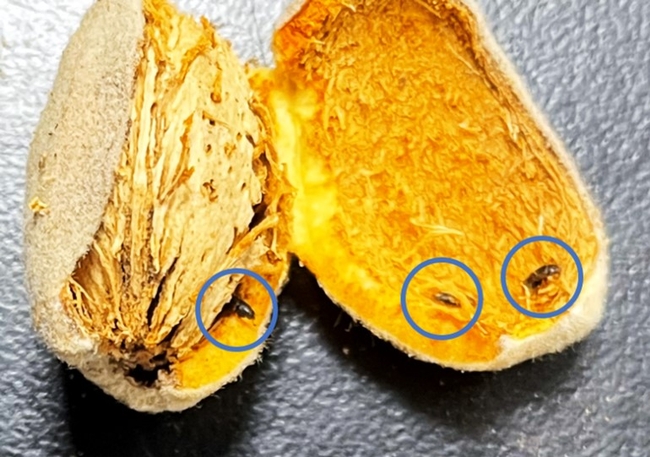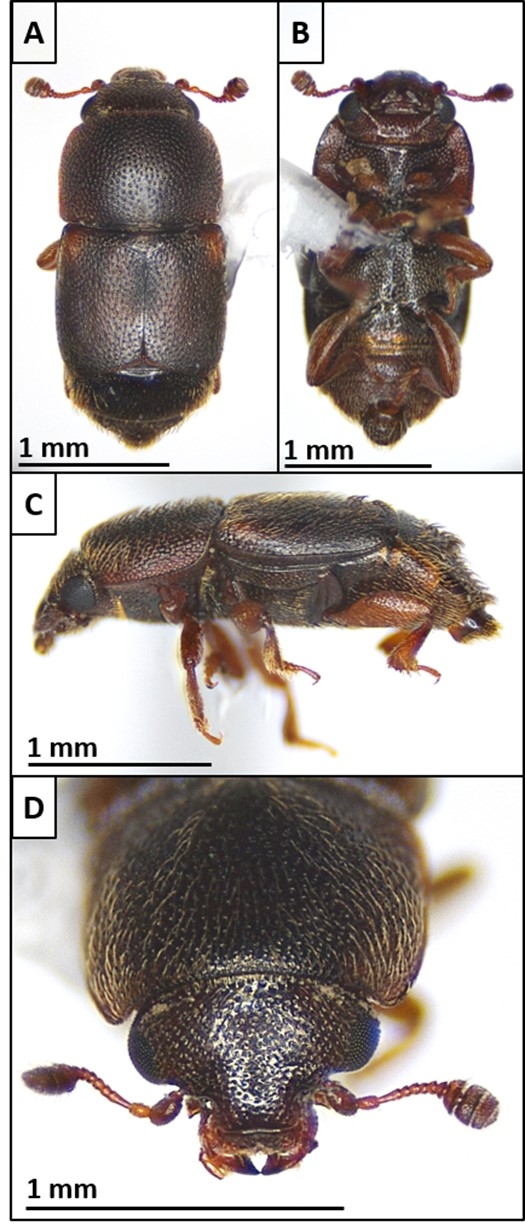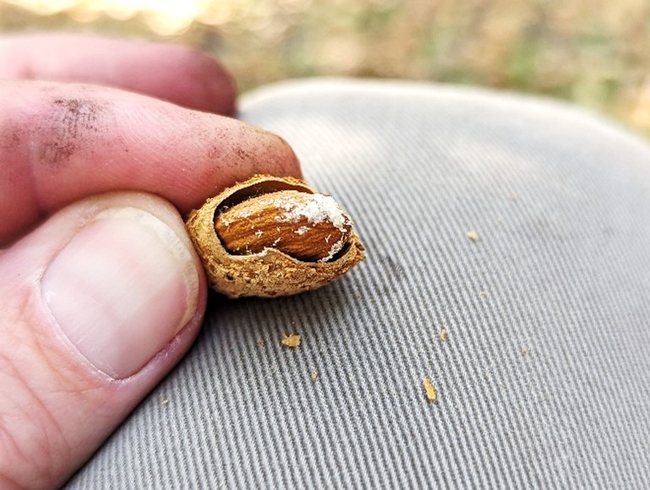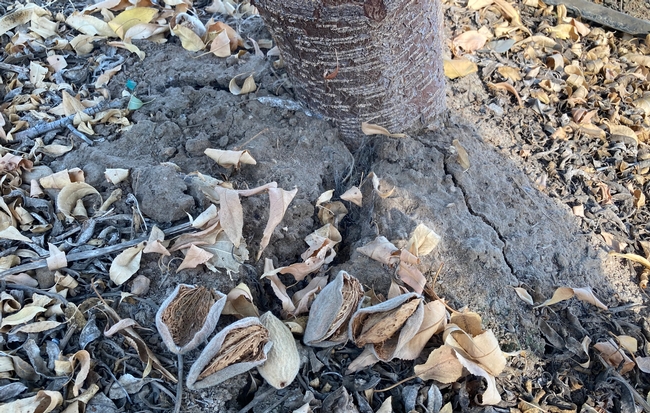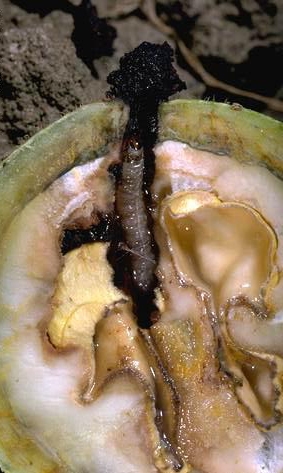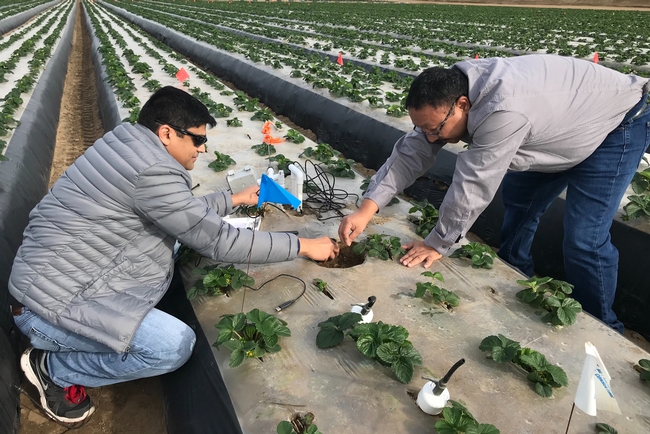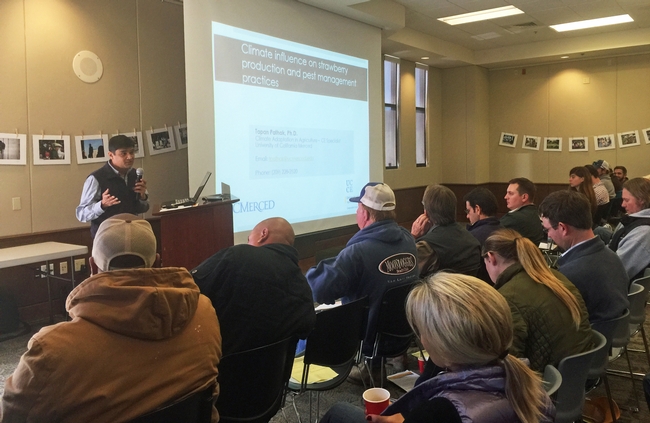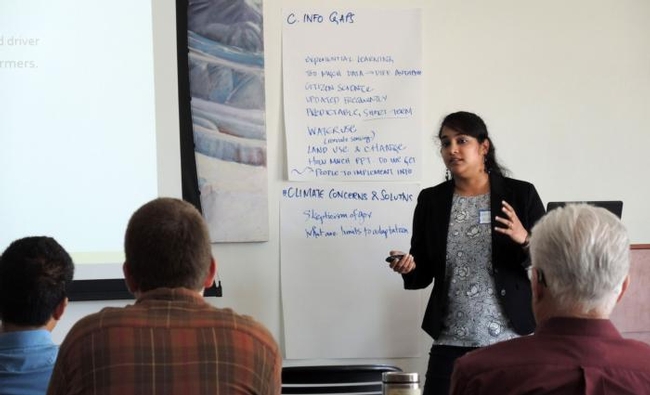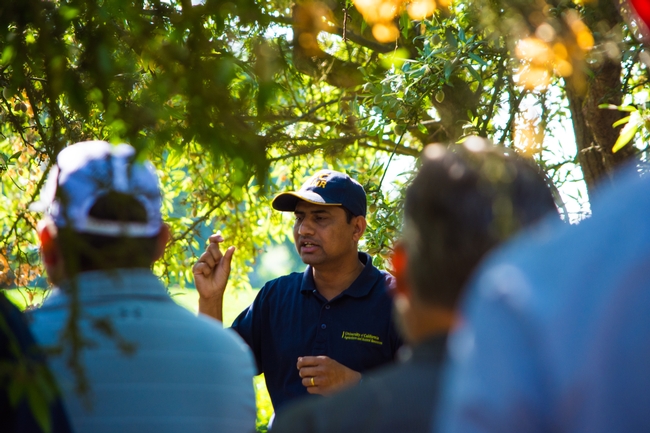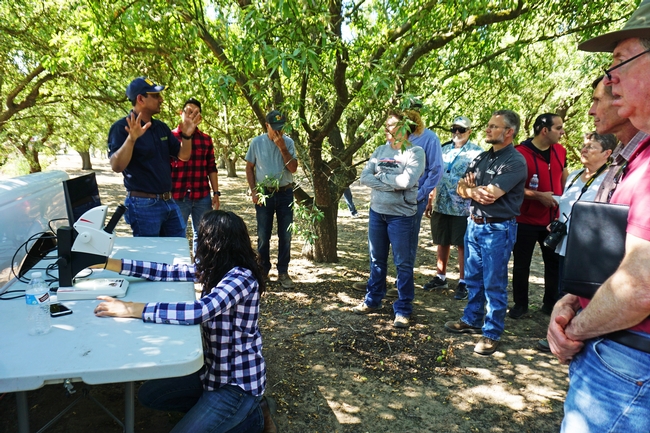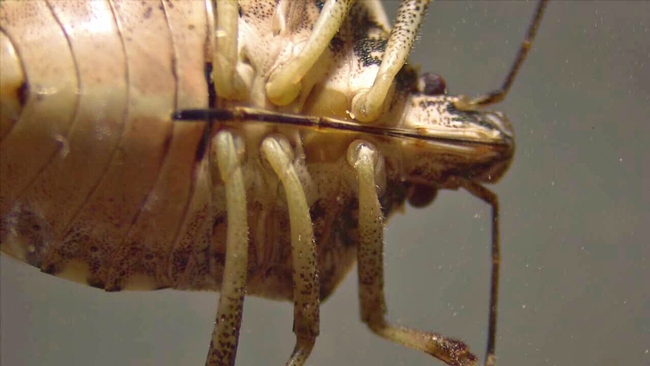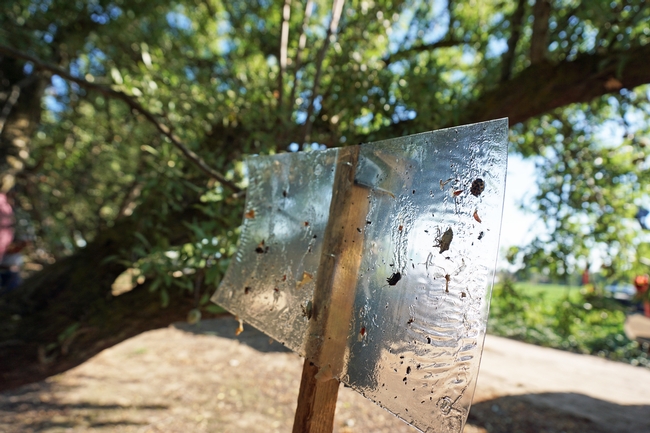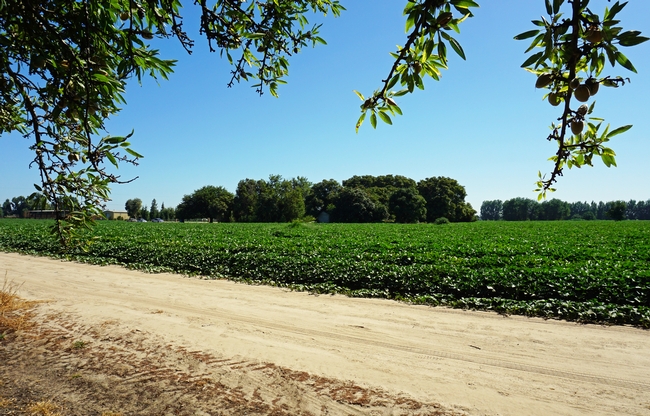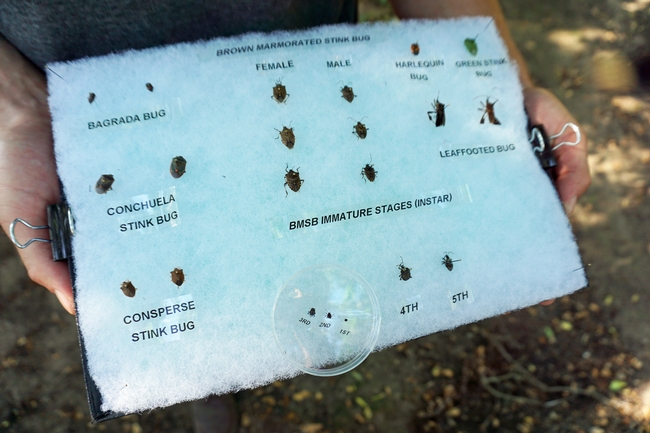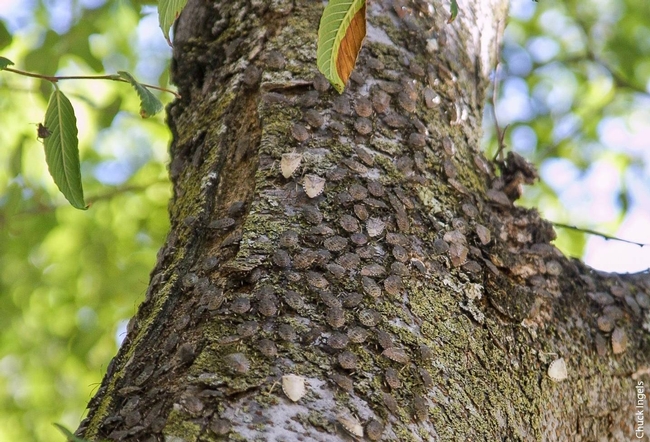Posts Tagged: Jhalendra Rijal
New pest infesting almonds and pistachios in the San Joaquin Valley
Crop sanitation will be key to controlling the invasive carpophilus beetle
Growers and pest control advisers (PCAs) should be on the lookout for a new pest called carpophilus beetle (Carpophilus truncatus). This pest was recently found infesting almonds and pistachios in the San Joaquin Valley, and is recognized as one of the top two pests of almond production in Australia. Damage occurs when adults and larvae feed directly on the kernel, causing reductions in both yield and quality.
Populations of carpophilus beetle were first detected in September in almond and pistachio orchards by University of California Cooperative Extension Specialist Houston Wilson of UC Riverside's Department of Entomology. Pest identification was subsequently confirmed by the California Department of Food and Agriculture.
Wilson is now working with Jhalendra Rijal, UC integrated pest management advisor, North San Joaquin Valley; David Haviland, UCCE farm advisor, Kern County; and other UCCE farm advisors to conduct a broader survey of orchards throughout the San Joaquin Valley to determine the extent of the outbreak.
To date, almond or pistachio orchards infested by carpophilus beetle have been confirmed in Stanislaus, Merced, Madera and Kings counties, suggesting that the establishment of this new pest is already widespread. In fact, some specimens from Merced County were from collections that were made in 2022, suggesting that the pest has been present in the San Joaquin Valley for at least a year already.
“It has likely been here for a few years based on the damage we've seen," Rijal said.
This invasive beetle overwinters in remnant nuts (i.e. mummy nuts) that are left in the tree or on the ground following the previous year's harvest. Adults move onto new crop nuts around hull-split, where they deposit their eggs directly onto the nut. The larvae that emerge feed on the developing kernels, leaving the almond kernel packed with a fine powdery mix of nutmeat and frass that is sometimes accompanied by an oval-shaped tunnel.
Carpophilus beetle has been well-established in Australia for over 10 years, where it is considered a key pest of almonds. More recently, the beetle was reported from walnuts in Argentina and Italy as well. Carpophilus truncatus is a close relative to other beetles in the genus Carpophilus, such as the driedfruit beetle (C. hemipterus) that is known primarily as a postharvest pest of figs and raisins in California.
Monitoring for carpophilus beetle is currently limited to direct inspection of hull split nuts for the presence of feeding holes and/or larvae or adult beetles. A new pheromone lure that is being developed in Australia may soon provide a better monitoring tool for growers, PCAs and researchers.
“We're lucky to have colleagues abroad that have already been hammering away at this pest for almost a decade,” said Haviland. “Hopefully we can learn from their experiences and quickly get this new beetle under control.”
The ability to use insecticides to control carpophilus beetle remains unclear. The majority of the beetle's life cycle is spent protected inside the nut, with relatively short windows of opportunity available to attack the adults while they are exposed. The location of the beetles within the nut throughout most of their life cycle also allows them to avoid meaningful levels of biological control.
In the absence of clear chemical or biological control strategies, the most important tool for managing this beetle is crop sanitation.
“Given that this pest overwinters on remnant nuts, similar to navel orangeworm, crop sanitation will be fundamental to controlling it,” Wilson said. “If you needed another reason to clean up and destroy mummy nuts – this is it.”
In Australia, sanitation is currently the primary method for managing this pest. And here in California, new research and extension activities focused on carpophilus beetle are currently in the works.
“It's important that we get on top of this immediately,” said Wilson. “We're already starting to put together a game plan for research and extension in 2024 and beyond.”
If you suspect that you have this beetle in your orchard, please contact your local UC Cooperative Extension farm advisor (https://ucanr.edu/About/Locations/), County Agricultural Commissioner (https://cacasa.org/county/) and/or the CDFA Pest Hotline (https://www.cdfa.ca.gov/plant/reportapest/) at 1-800-491-1899.
A hike in navel orangeworm pressure expected later this century due to climate change
Outsized wildfires, rising sea levels and disappearing glaciers are dramatic signs of climate change, but not the only ones. New UC Agriculture and Natural Resources research provides forewarning of a change that will be economically and environmentally costly to California – a fifth generation of navel orangeworm, the most destructive pest of almonds, walnuts and pistachios.
Navel orangeworm (NOW) will be more problematic in the future because of warming temperatures, UC Cooperative Extension scientists report in Science of the Total Environment.
Like most insects,NOW's development rate, physiology, behavior and reproduction are highly dependent on the ambient temperature. When the weather warms in the spring, NOW moths emerge from the nuts left in the tree or on the ground during the winter. After mating, females then recycle those last year's nuts to lay eggs and complete one generation. Adults emerged from that first and subsequent generations then lay eggs on in-season hull-splitalmondnuts, where larvae feeding damages the crop. Typically the pests fly three to four times per year – with more flights in areas with warmer weather.
“Warmer temperatures can result in early activity of the pests in the spring and increased activity during the season,” said Tapan Pathak, the UC Cooperative Extension climate change specialist and the study's principle investigator.
The scientists looked at 10 climate models to determine what nut farmers can expect to face over the next 80 years and applied NOW developmental models to the changing climate. Daily maximum and minimum temperature data were obtained for 1950 to 2005, and future projections stretched to 2100.
“The fifth generation can happen in the next few decades,” said Jhalendra Rijal, UC integrated pest management advisor and co-author of the research. “The climate models suggest that spring will begin earlier. That causes insect activity to start earlier. With increased temperatures through the season, the number of days to complete a generation is less. At the end of 2050 or so, we'll see an extra generation.”
The study focused on 23 counties in the Central Valley, from Shasta County in the north to Kern County in the south, where 1.78 million bearing acres of nut crops are planted. About two-thirds of that acreage is planted to almonds, 20% in walnuts and 16% in pistachios. The tree nut crops were valued at more than $8 billion combined in 2018, according to the California Department of Food and Agriculture.
The completion of the NOW life cycle is faster in pistachio compared to almonds and walnuts, so the potential risk of crop damage and economic loss is higher in pistachio, according to the research report. There are only a few years historically in which the models detected the fifth generation of NOW in Kern County pistachios. The occurrence of the fifth generation in almonds and walnuts was historically nonexistent, but it starts appearing in three southern counties by 2040 and eleven counties by 2100.
“In order to alleviate some of the risks related to navel orangeworm damage to nut crops, it is important to implement integrated pest management practices,” Pathak said.
IPM preventative and control measures include sanitizing the orchard during the winter by removing all the nuts on the ground and in the trees, applying synthetic reproductive hormones to limit the pests' ability to find mates, encouraging natural enemies, judicious of least-toxic pesticides if necessary and harvesting the crop early to avoid a new generation of the pest.
“A better understanding of future navel orangeworm pressure on California's major nut crops can help facilitate and strategize integrated pest management practices in order to minimize production risks,” Pathak said.
The results of the research can also inform growers and pest control advisers about the potential increased threat from other pests as the climate changes.
New $1 million research project to test mating disruption for pest control in walnuts
The Community Alliance with Family Farmers and UC Cooperative Extension are working with farmers to establish six demonstration sites in walnut orchards that will examine the effectiveness of mating disruption to control two major pests of the crop – codling moth and navel orangeworm.
The three-year research effort is funded with a $1 million award from the California Department of Agriculture Biologically Integrated Farming Systems program.
“The project sites will be in the Sacramento and northern San Joaquin Valleys, but we expect the demonstration to be of interest to walnut farmers across the state,” said Sara Tiffany, CAFF director of ecological farming and the project lead. “Farmers who grow related crops, like almonds and pistachios, will also be able to benefit from the findings.”
Over the past 55 years, conventional walnut farmers have often turned to the broad-spectrum pesticide chlorpyrifos – commonly known by the trade name Lorsban – to protect the crop from codling moths and navel orangeworm. However, California regulators have determined it may no longer be used in the state as of Dec. 31, 2020.
“Farmers need alternatives. In this project, we will be studying the effectiveness of alternatives that already exist,” said Jhalendra Rijal, UC Cooperative Extension integrated pest management advisor for San Joaquin, Stanislaus and Merced counties, the lead scientist on the project. The California Walnut Board is also part of the project team.
Six farmers will be recruited to enroll at least 80 acres each in the demonstrations – three farmers in the Sacramento Valley and three in the northern San Joaquin Valley. The entire acreage will be managed following UC IPM guidelines for walnut production, including cover crops, reduced risk pesticide options and biological control.
Forty acres will be treated with commercially available mating disruption products, while the other 40 acres will not. The treatment works by confusing the pests. Codling moth and navel orangeworm moths naturally release pheromones that help them find mates. The female lays eggs in the immature nuts, and when they hatch, the larvae feed on the nuts, rendering them unmarketable. In the treated area, the orchards will be flooded with a synthetic pheromone that makes it much more difficult for male and female pests to hone in on one another.
Besides codling moth and navel orangeworm, the project will systematically look at the effects of cover crops and predatory mite release on pest mite populations, and improvement in other natural enemy populations in walnut orchards.
The results of the IPM practices will be shared widely with growers, pest control advisors and certified crop consultants in articles, meetings and field days.
“Currently the use of mating disruption in walnuts is significantly lower than in almonds,” said Rijal, who is also the associate director for Agricultural IPM with the UC Statewide IPM Program. “We believe when farmers see the results of using mating disruption, along with other sustainable walnut production practices, we will improve the adoption rate.”
Climate-change research provides tools for farmers to adapt
This is one of a series of stories featuring a sampling of UC ANR academics whose work exemplifies the public value UC ANR brings to California.
Farmers are already seeing the effects of warmer winter nights and hotter summer days on their crops. Climate change is gradual, but increasing overall temperatures affect many aspects of farming, including where and how crops are grown. Tapan Pathak, University of California Cooperative Extension specialist based at UC Merced, is doing applied research that farmers and ranchers can use to adapt to new conditions created by a variable and changing climate.
“You don't have to shift your practice tomorrow, but if you are thinking of making a 30-year investment, it's important to know what risks there are for planting different crops,” said Pathak, who is based in the Sierra Nevada Research Institute at UC Merced.
Pathak co-chairs the UC Cooperative Extension Climate Change Program Team, whose mission is to increase the capacity among UCCE academics to address climate change concerns with science-based information. Pathak also collaborates with extension professionals from across the western U.S. to do extension events related to climate change adaptation. He works closely with state and federal agencies statewide and growers to identify changes occurring as a result of climate change that affect agriculture. Pathak's research will inform growers' decisions, such as crop variety, planting and harvest dates, extreme heat and frost protection and pest management.
“We are seeing impacts of climate change, that's evident. We have some solutions that are available, but we also need to do more locally relevant crop specific research to make agriculture resilient to climate risks,” Pathak said.
The UCCE scientist was the lead author on an important paper that synthesized the impacts of climate change on California agriculture and offers directions for future research and implementation. The authors concluded that almost all of California's crops, collectively valued at more than $50 billion a year, will be endangered to some degree by rising temperatures and variable weather patterns. The study “Climate Change Trends and Impacts on California Agriculture” was published in Agronomy in 2018.
“I think there's a lot of solutions available and there is also a clear need for adaptation research that include growers' perspectives,” said Pathak, who received a Climate Leadership Award for research from the California Climate & Agriculture Network.
Pathak is also collaborating very closely with UC Davis-based UCCE specialist Daniele Zaccaria, who is leading an international project on evaluating bioclimatic indices and developing the index that is more relevant to irrigated agriculture, which includes scientists from the U.S., Italy, Brazil and Chile.
“A bioclimatic index specific to irrigated agriculture can provide more accurate and valuable agricultural drought information that could be helpful for water resources planning and management decisions,” Pathak said.
Cal AgroClimate
Pathak is developing a web-based decision support system called Cal AgroClimate to help growers make decisions, in partnership with the USDA California Climate Hub director Steven Ostoja. It is being built on the same platform as AgroClimate, which is popular with growers in the Southeast.
Cal AgroClimate translates historical climate data and future projections into a useful decision support system for growers. For example, growers can get extreme heat and frost advisories for the next 10 to 14 days in their region and relevant resources to mitigate risks for their selected crop. It is in the early phase of development and will include a suite of tools based on the needs and priorities identified by UCCE colleagues, growers and the agricultural community in general.
In addition to his work on Cal AgroClimate, Pathak has been conducting research on specific crops.
Tomatoes
In a study looking at processing tomato production in the Central Valley, Pathak and UCCE advisor Scott Stoddard found that changing temperatures will likely change the tomato growing season. The scientists looked at processing tomato data starting from 1950 and projections for 2030-2040 to see how the time to maturity is changing.
“In general, the time from emergence to maturity, the timeframe for processing tomatoes in that region is going to shrink by two to three weeks,” said Pathak. “A lot of processors have their timeline for when they need the tomatoes for processing and so when you have this shift in the phenology, that alters the timeframe for when they mature and are ready for the processors. So, there's a whole shift in the management that growers might have to think about in the future.”
Almonds
To identify the climate information almond growers need to take adaptation action, UC Berkeley postdoctoral researcher Kripa Jagannathan, former UCCE advisor David Doll and Pathak interviewed almond growers in the Central Valley. During their conversations with farmers, the researchers clarified that long-term climate projections are not seasonal forecasts or weather forecasts for the next 20 to 30 years. The projections provide information on trends or potential of shifts from historical conditions for making long-term planning decisions.
Pest control is one area where growers will need to make changes. Research by UCCE advisor Jhalendra Rijal and Pathak shows the almond pest navel orangeworm is already extending its life to a fifth generation during a season.
Strawberries
For strawberries, Pathak, UCCE entomology and biologicals advisor Surendra Dara and postdoctoral researcher Mahesh Maskey have developed a model to forecast weekly crop yields based on weather data. “The model was pretty accurate for the Santa Maria region,” Pathak said. “A crop-specific model can be used for labor management not just crop management.”
Because California produces more than 400 agricultural products, adapting to climate change will be more complex than in other states.
UCCE advisor addresses severe brown marmorated stink bug damage in Turlock orchard
Last May, a Turlock almond grower noticed nearly all the nuts on a row of trees in his orchard had fallen to the ground.
“It looked like we shook this row,” he said. “I was scared. I thought the whole orchard was going to go.”
He called UC Cooperative Extension.
UCCE Integrated Pest Management advisor Jhalendra Rijal, who serves Stanislaus, San Joaquin and Merced counties, determined the cause was an infestation of brown marmorated stink bug (BMSB), an invasive pest from Asia. For years, BMSB had only been found in urban areas of California – most notably a 2013 infestation in midtown Sacramento.
With few natural predators and a wide host range – including apples, pears, cherries, corn, tomatoes, grapes and a variety of landscape trees – the population eventually moved into agricultural areas, first appearing in crops in 2016 in Stanislaus County. Rijal has been doing BMSB research since then.
Rijal hosted a gathering of farmers and pest control advisers Aug. 13, 2019, in the Turlock almond orchard to give them a first-hand view of the pest and the problems it causes.
BMSB are hard to find in orchards. They lay greenish colored eggs on the underside of leaves, typically in a cluster of 28 eggs. The majority of damage is caused by adults, which sting the hull with a needle-like mouth part to get to the nut. The sting can even penetrate the almond's hard shell when the fruit is mature.
Globs of clear sticky sap appear on the damaged almond hulls, typically indicating nut loss inside. Early season (March-April) infestation leads to the most severe yield loss when the nuts drop to the ground. The best way to confirm the damage is caused by BMSB is to use a trap.
“I recommend growers and pest control advisors put BMSB traps in orchard edges if they suspect BMSB damage or if the orchard is located near potential overwintering structures or host crops,” Rijal said. “BMSB are good flyers and active throughout the season, damaging nuts from April through the fall. But the most substantial damage happens in the spring through early summer."
If the orchard is close to BMSB-favored host plants, more damage is seen. A particularly troublesome neighbor plant is tree-of-heaven.
“Tree-of-heaven is a magnet for BMSB,” Rijal said, pointing to an abandoned farmhouse site on an adjacent property. “Tree-of-heaven has a nice fruiting structure that can support a lot of BMSB.”
Also an Asia native, tree-of-heaven was brought to California by Chinese immigrants during the Gold Rush. The roots, leaves and bark are used in traditional Chinese medicine. But its rapid growth and ability to clone itself to develop thick groves make it a noxious weed.
BMSB isn't a serious pest in its homeland because it is controlled by a natural enemy. Charles Pickett, the California Department of Food and Agriculture biological control scientist, shared a mounted sample of a Samurai wasp from Asia, Trissolcas japonicus, which lays its eggs in BMSB eggs.
“The parasite attacks most of the eggs in the field in eastern Asia,” Pickett said. “It's our goal to release the wasp in California. We first need a special permit to make sure it won't harm our environment and doesn't attack any beneficial stink bugs.”
The Samurai wasp has already found its own way to some BMSB infestation sites in the Eastern U.S. and in Los Angeles.
“We hope to someday release the parasitic wasp,” Pickett said. “It won't eradicate BMSB, but it will help.”

